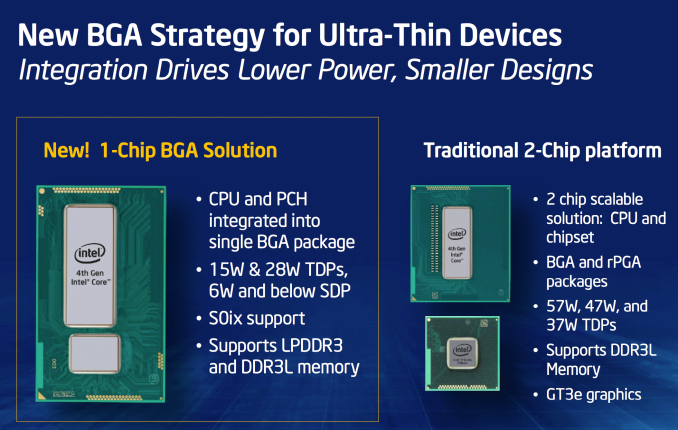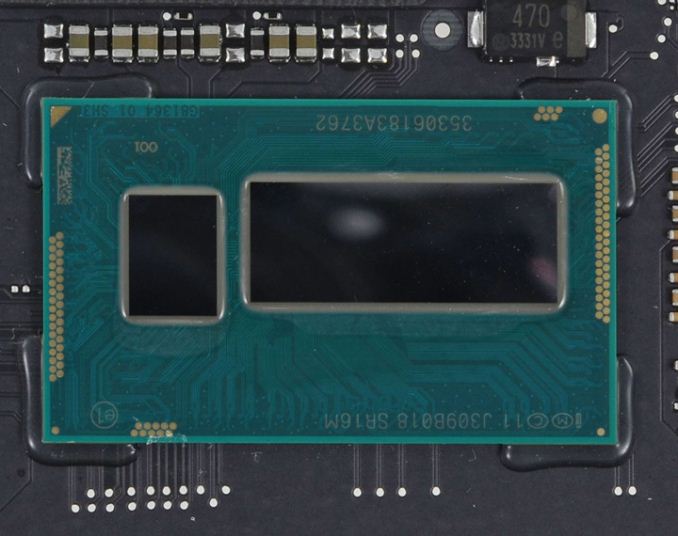The 2013 MacBook Air Review (13-inch)
by Anand Lal Shimpi on June 24, 2013 12:01 AM ESTThe CPUs
Apple keeps things simple across the 2013 MacBook Air lineup by configuring both 11 and 13-inch models with the same base CPU: a Core i5-4250U.
To understand Apple’s CPU choice, you have to understand that Apple is primarily concerned about improving battery life this generation. The line between MacBook Air and MacBook Pro has to be well defined. The Air is about portability, while the Pro is about performance. When faced with a power/performance tradeoff, it’s clear on which side of the fence Apple will fall whenever the MacBook Air is concerned.
| Apple 2013 MacBook Air CPU Comparison | |||||
| 1.3GHz dual-core | 1.7GHz dual-core | ||||
| Standard On | 11 & 13-inch MBA | Optional on Both | |||
| Intel Model | Core i5-4250U | Core i7-4650U | |||
| Base Clock Speed | 1.3GHz | 1.7GHz | |||
| Max SC Turbo | 2.6GHz | 3.3GHz | |||
| Max DC Turbo | 2.3GHz | 2.9GHz | |||
| L3 Cache | 3MB | 4MB | |||
| TSX-NI | No | Yes | |||
| TXT | No | Yes | |||
| AES-NI | Yes | Yes | |||
| VT-x/VT-x EPT | Yes | Yes | |||
| VT-d | Yes | Yes | |||
| TDP | 15W | 15W | |||
| Processor Graphics | Intel HD 5000 | Intel HD 5000 | |||
| GPU Clock (Base/Max) | 200/1000MHz | 200/1100MHz | |||
The lower base clock alone shouldn’t mean much, but the max TDP of the CPUs in the new MacBook Air falls as well - from 17W down to 15W. The thermal limit is even more dramatic since with Haswell ULT, the 15W includes the CPU/GPU as well as the on-package PCH. In Ivy Bridge the PCH was off package and wasn’t included in the 17W TDP.
Max turbo clocks are identical between the Haswell ULT CPUs Apple picked this round and the Ivy Bridge models before, but with a lower TDP it’ll be harder to always sustain the same frequencies given the right workload.
Haswell does feature a not insignificant gain in IPC compared to Ivy Bridge, which should help offset the power constraints that could otherwise force a larger regression in performance.
Both 2013 MBAs ship with the same CPU by default, and both can be upgraded to the same higher end SKU: a Core i7-4650U. The 4650U retains the same 15W TDP as the i5-4250U, but it increases its base clock speed to 1.7GHz and max turbo to 3.3GHz. The L3 cache also grows from 3MB to 4MB. All in all, this should be a very healthy upgrade in performance. Intel likely maintains the same TDP by binning for power; the i7-4650U is probably capable of running at higher frequencies without any appreciable increase in voltage. The max GPU clock also goes up by 10%.
Haswell ULT, Courtesy iFixit
What's arguably coolest about the i7-4650U is it enables Haswell's Transactional Synchronization Extensions (TSX-NI), a feature which is unfortunately disabled on the i5-4250U. I don't suspect this will matter much for most MBA users, but anyone looking to play around with Haswell's TSX instructions will want to opt for the higher end SKU. The upgrade costs $150 regardless of base model. Intel charges $454 for the i7-4650U and $342 for the i5-4250U, a difference of $112; Apple is adding another $38 onto the 1KU pricing, which isn't unreasonable.
Many have asked me what the impact of the i7 will be on battery life. I'm hoping to get my hands on an i7 based machine when I return from the UK in a week, but for those of you making immediate decisions I'll offer the following. Sustained operation at higher frequencies will likely draw more power, and negatively impact battery life. Light to medium workloads will enjoy a mix of race to sleep benefits as well as higher power consumption under load. Idle power should be roughly similar between the parts however. For most workloads I'd expect a modest impact to battery life, but it won't be enough to regress to 2012 levels of battery life. All of this is said without knowing key details like operating voltage for most 4650Us. I plan on addressing that shortly.












233 Comments
View All Comments
spronkey - Monday, June 24, 2013 - link
Hmm. Very interested to see the CPU and battery life numbers for the i7 upgrade. If it manages to increase performance by 10% or so, and decrease battery life 10% or so, it could be a nice sweet spot.Bkord123 - Tuesday, June 25, 2013 - link
I can't wait for the i7 review. I think it's the once I'm leaning toward getting.timmyj9 - Monday, June 24, 2013 - link
i would be curious to know if the same 802.11ac file sharing bottlenecks occur when using NFS as the file sharing protocol?Kevin G - Monday, June 24, 2013 - link
It would as the tweak to resolve it was made to TCP and modern NFS are built on top of that.Khato - Monday, June 24, 2013 - link
Can't agree more that Haswell battery life is already blurring the lines with current tablets. I'm curious how the 2013 Tablet Bench Web Browsing suite compares specifically to the one used on notebooks? In the details provided in this review the specific frequency of web page loading is specified while it's not in the Tablet version.The iPad 4 with it's 42.5Wh battery and 9.48 hours of run-time in the test draws an average of 4.48W. If that test is comparable to the Light version shown here then you have the Haswell Macbook Air drawing an average of 4.9W, while if it's comparable to the Medium version then the average is 6.05W. Either way, when you consider that the Macbook Air's 13.3" diagonal screen has 1.88x more surface area than the iPad 4 (nit is another term for cd/m^2, so total luminous intensity of a 13.3" screen at 200 nits is 1.88x that of a 9.7" screen at 200 nits) it's pretty much a given that display power for the Macbook Air is higher than for the iPad 4 despite the lower resolution. Pretty cool.
Shivansps - Monday, June 24, 2013 - link
The HD5000 is running on single channel right? there is a 2do slot for another memory?Kevin G - Monday, June 24, 2013 - link
The entire SoC has dual channel memory. The MacBook Air has no memory expansion slots. If you want to get one of these, be sure to order with the amount of memory you think you'd need in the future.Shivansps - Monday, June 24, 2013 - link
Im saying that because of the IGP performance, i cant find any confirmation on the review that the MBA is running on dual channel memory, 4GB LPDDR3 sounds like 64 bit single channel to me, and that will impact IGP performance, even HD3000 has reduced 3D performance if not running on dual channel.Glindon - Monday, June 24, 2013 - link
Every Macbook Air that I've owned ran in dual channel mode. Why would this year's be any different.Kevin G - Monday, June 24, 2013 - link
Note the part in this article referring to the LPDDR3. It indicates that it has four 32 bit LPDDR3 packages which indicate a 128 bit wide bus (dual channel).